
Challenger No6
Nordic Folkboat built in Norway in 1960. 25.1 ft Long
22 June 2008 | SYC Shoreham
06 June 2008 | SYC Shoreham
06 June 2008 | Sussex Boat Yard
26 May 2008 | Shoreham
14 April 2008 | Shoreham by Sea
06 February 2008 | Shoreham
04 September 2007 | Shoreham
22 August 2007 | Shoreham
20 August 2007 | Shoreham
16 August 2007 | Shoreham
16 August 2007 | Shoreham
12 August 2007 | Pees Pottage Service Station
25 June 2007 | Market Bosworth
11 November 2006 | Market Bosworth
11 November 2006 | Market Bosworth
07 September 2006 | Market Bosworth
23 May 2006 | Market Bosworth
07 May 2006 | Market Bosworth
06 May 2006 | Market Bosworth
06 April 2006 | Market Bosworth
Standard Black Coal Tar Solution
22 June 2008 | SYC Shoreham
David Mutlow
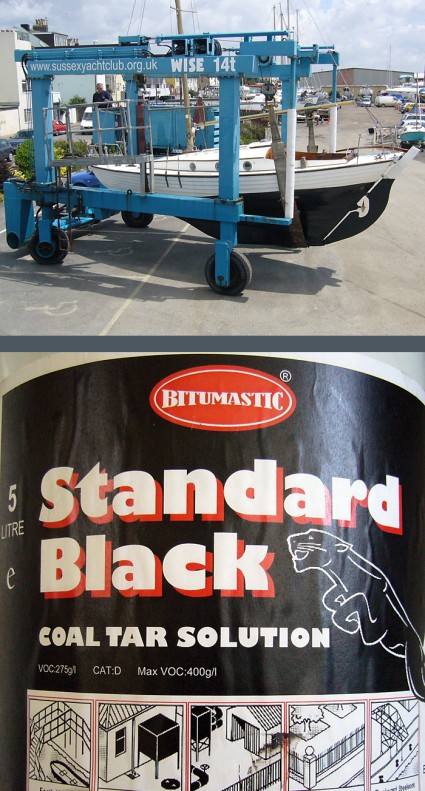
Re-launched yesterday the combination of White lead putty and Coal tar as an antifoul seems to have done the trick.
Ready for launch
06 June 2008 | SYC Shoreham
David Mutlow

Its recommended to wait 24 hours for each coat of Coal tar varnish to dry. The finish is a gloss black.
Coal Tar Varnish
06 June 2008 | Sussex Boat Yard
David Mutlow / Overcast

After using the white lead putty I applied 3 coats of 'Coal Tar Varnish' used on Thames Barges. Talking to Rylard Paints in Liverpool their 'Standard Black' was recommended as it also penetrates the wooden hull and acts as a preservative. Speaking to their representative I was informed I could (If I wanted to) paint an antifoul on top after the 'Standard Black' had been weathered for 6 month.
http://www.rylardboats.com/hull.aspx
http://www.rylardboats.com/hull.aspx
White Lead paste putty
26 May 2008 | Shoreham
David Mutlow
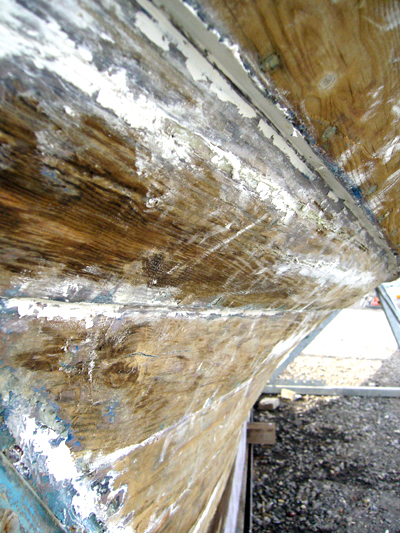
I covered Challenger's seams with 'White Lead Paste Putty' which is super sticky. The idea been that as she is lowered into the water the water pressure will force the putty into the seams and plug the small leaks.
http://www.davey.co.uk/where_to_buy_davey_and_co.html
http://www.davey.co.uk/where_to_buy_davey_and_co.html
Creosote Substitute
14 April 2008 | Shoreham by Sea
David Mutlow
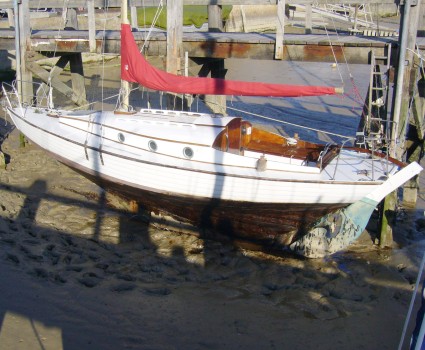
With the prospect of sailing in warmer waters, I covered the bare hull with a coat of Creosote Substitute. A recommendation in one of 'Lin & Larrys Books' to avoid the Toledo worm. International primer still sticks to the Creosote coating with ease.
Removing Antifoul in the Mud
06 February 2008 | Shoreham
David Mutlow | Wet and windy
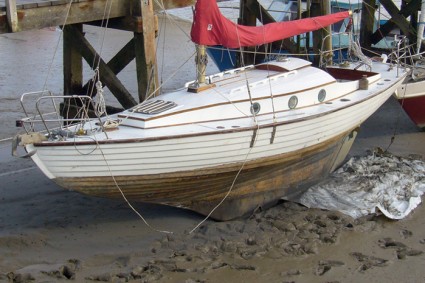
After 3 months the hull still leaked too much, although clinker hulls do have a reputation for leaking a little. So I decided to remove the paint from the hull and let the planks soak, free of antifoul. There were 6 layers of old antifoul to remove which was acting as a water barrier to the wood. The hull should swell properly now!
Home berth
04 September 2007 | Shoreham
David Mutlow

Its taken 2 weeks from launch to move Challenger 100 yards to her home berth. I've had her looked at and nobody can see any problems. She has been out the water for 5 years so she will leak more as I sail her and stress her hull as it moves. Consensus of opinion is that she will not fully take up unless used. She will always leak compared to a carvel hull. But 2 mins of hand pumping after a sail is not a problem and as she is used she will tighten up even further.
Temporary berth
22 August 2007 | Shoreham
David Mutlow
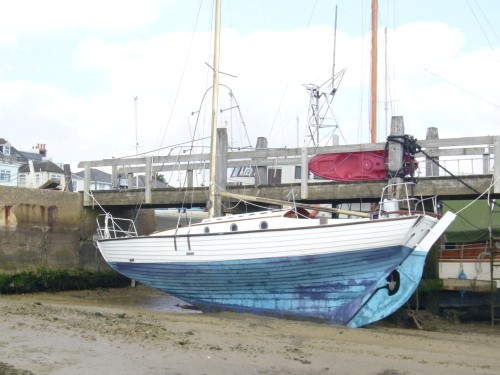
On the 4th day of flooding and resting on chocks a large speed boat lifted me off my legs with my seacocks open. Bailing frantically I was able to keep her just upright until another member saved the day with a petrol powered water pump.
Deliberate Flooding
20 August 2007 | Shoreham
David Mutlow

Challenger began to take up more quickly and the pumping became less often, at this stage Challenger leaked about 2 gallons an hour. This was still an alarming rate but a vast improvement compared to her launch
Launch Day
16 August 2007 | Shoreham
David Mutlow
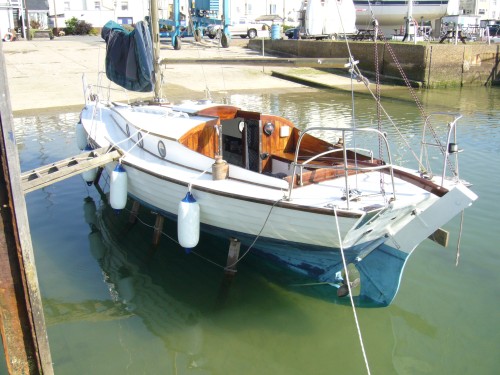
My main concern was with the Garboard plank and where its seam met the keel; fortunately, this was the first seam to close. After 4 days on the slipway, I was getting impatient. I felt Challenger was not getting wet enough; the receding high tide was having less effect. Therefore, with a large capacity pump I floated Challenger to an adjacent mud berth using warps and lines, allowing her to flood up to a point. As I had done with the Ketch, I deliberately allowed water to stay inside Challenger but this time only enough to cover the bilges so that the lower seams near the Garboard plank were soaked continually when the tide was out.
| Vessel Name: | Challenger No6 |
| Vessel Make/Model: | Nordik Folkboat [Clinker Hull] |
| Hailing Port: | Shoreham, UK |
| Crew: | David Mutlow |
| Extra: | Challenger has been modified for extended cruising [solo or 2 crew usage]. She has a Bukh 10Hp inboard engine with a piggy back alternator charged from a 12" pulley attached to the propshaft. Although a 3/4 rig, Challeneger's been modified to fly a light air cruising shute from the Top of the mast. |
| Home Page: | http://www.photographer.uk.com |
Gallery not available
Challenger No6
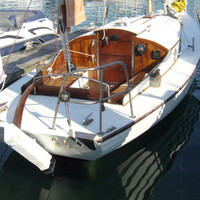
Who: David Mutlow
Port: Shoreham, UK